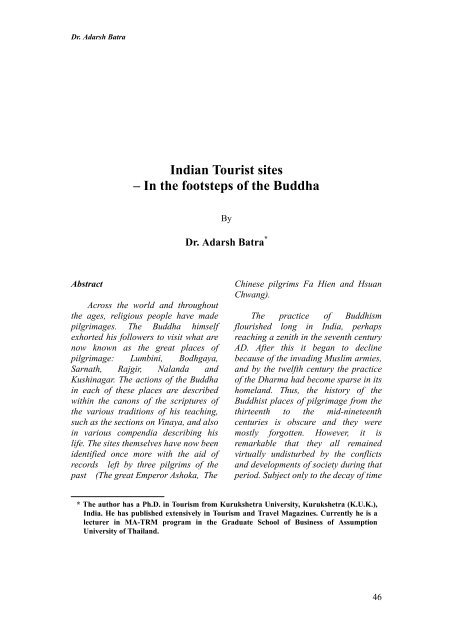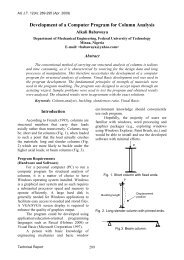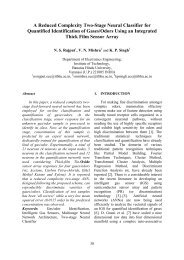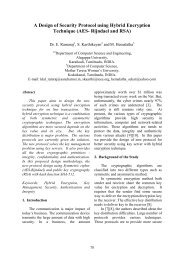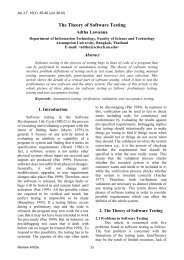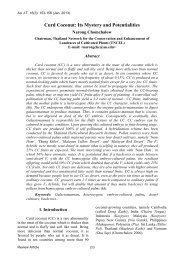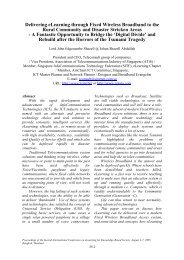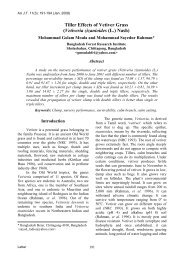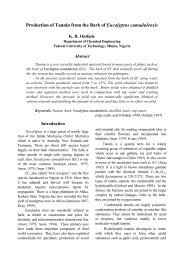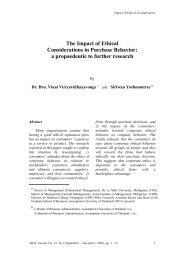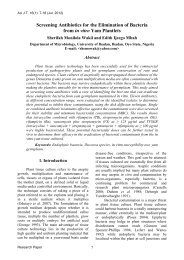Indian Tourist sites â In the footsteps of the Buddha - AU Journal ...
Indian Tourist sites â In the footsteps of the Buddha - AU Journal ...
Indian Tourist sites â In the footsteps of the Buddha - AU Journal ...
You also want an ePaper? Increase the reach of your titles
YUMPU automatically turns print PDFs into web optimized ePapers that Google loves.
Dr. Adarsh Batra<br />
<strong><strong>In</strong>dian</strong> <strong>Tourist</strong> <strong>sites</strong><br />
– <strong>In</strong> <strong>the</strong> <strong>footsteps</strong> <strong>of</strong> <strong>the</strong> <strong>Buddha</strong><br />
By<br />
Dr. Adarsh Batra *<br />
Abstract<br />
Across <strong>the</strong> world and throughout<br />
<strong>the</strong> ages, religious people have made<br />
pilgrimages. The <strong>Buddha</strong> himself<br />
exhorted his followers to visit what are<br />
now known as <strong>the</strong> great places <strong>of</strong><br />
pilgrimage: Lumbini, Bodhgaya,<br />
Sarnath, Rajgir, Nalanda and<br />
Kushinagar. The actions <strong>of</strong> <strong>the</strong> <strong>Buddha</strong><br />
in each <strong>of</strong> <strong>the</strong>se places are described<br />
within <strong>the</strong> canons <strong>of</strong> <strong>the</strong> scriptures <strong>of</strong><br />
<strong>the</strong> various traditions <strong>of</strong> his teaching,<br />
such as <strong>the</strong> sections on Vinaya, and also<br />
in various compendia describing his<br />
life. The <strong>sites</strong> <strong>the</strong>mselves have now been<br />
identified once more with <strong>the</strong> aid <strong>of</strong><br />
records left by three pilgrims <strong>of</strong> <strong>the</strong><br />
past (The great Emperor Ashoka, The<br />
Chinese pilgrims Fa Hien and Hsuan<br />
Chwang).<br />
The practice <strong>of</strong> Buddhism<br />
flourished long in <strong>In</strong>dia, perhaps<br />
reaching a zenith in <strong>the</strong> seventh century<br />
AD. After this it began to decline<br />
because <strong>of</strong> <strong>the</strong> invading Muslim armies,<br />
and by <strong>the</strong> twelfth century <strong>the</strong> practice<br />
<strong>of</strong> <strong>the</strong> Dharma had become sparse in its<br />
homeland. Thus, <strong>the</strong> history <strong>of</strong> <strong>the</strong><br />
Buddhist places <strong>of</strong> pilgrimage from <strong>the</strong><br />
thirteenth to <strong>the</strong> mid-nineteenth<br />
centuries is obscure and <strong>the</strong>y were<br />
mostly forgotten. However, it is<br />
remarkable that <strong>the</strong>y all remained<br />
virtually undisturbed by <strong>the</strong> conflicts<br />
and developments <strong>of</strong> society during that<br />
period. Subject only to <strong>the</strong> decay <strong>of</strong> time<br />
* The author has a Ph.D. in Tourism from Kurukshetra University, Kurukshetra (K.U.K.),<br />
<strong>In</strong>dia. He has published extensively in Tourism and Travel Magazines. Currently he is a<br />
lecturer in MA-TRM program in <strong>the</strong> Graduate School <strong>of</strong> Business <strong>of</strong> Assumption<br />
University <strong>of</strong> Thailand.<br />
46
<strong><strong>In</strong>dian</strong> <strong>Tourist</strong> <strong>sites</strong><br />
– <strong>In</strong> <strong>the</strong> <strong>footsteps</strong> <strong>of</strong> <strong>the</strong> <strong>Buddha</strong><br />
<strong>the</strong>y remained dormant, waiting for<br />
rediscovery.<br />
From <strong>the</strong> middle <strong>of</strong> <strong>the</strong> last century,<br />
<strong>the</strong> Archeological Survey <strong>of</strong> <strong>In</strong>dia,<br />
under <strong>the</strong> auspices <strong>of</strong> <strong>the</strong> British<br />
Government, and one Englishman in<br />
particular--General Sir Alexander<br />
Cunningham--unear<strong>the</strong>d and identified<br />
many <strong>sites</strong>. Since that time, owing to a<br />
renewed <strong><strong>In</strong>dian</strong> interest in Buddhism<br />
and <strong>the</strong> devotion and hardship <strong>of</strong> many<br />
individuals, <strong>the</strong> pilgrimage <strong>sites</strong> have<br />
been revived.<br />
The following account is intended<br />
less to present a purely historical<br />
record <strong>of</strong> <strong>the</strong> places <strong>of</strong> pilgrimage than<br />
to <strong>of</strong>fer some information and perhaps<br />
inspiration to o<strong>the</strong>r pilgrims, with <strong>the</strong><br />
wish that this revival may increase.<br />
INTRODUCTION<br />
<strong>In</strong> 566 BC, in <strong>the</strong> little state <strong>of</strong><br />
Kapilvastu at <strong>the</strong> foot <strong>of</strong> <strong>the</strong> Himalayas,<br />
was born a son, Siddharatha, to<br />
Suddhodana, a Sakya prince, and his<br />
wife Mayadevi. Seers proclaimed that<br />
<strong>the</strong> new-born would ei<strong>the</strong>r conquer <strong>the</strong><br />
world or be a <strong>Buddha</strong>- <strong>the</strong> enlighted<br />
one. The prophesy came true when<br />
Gautama attained Supreme Knowledge<br />
(bodhi) and laid <strong>the</strong> foundation <strong>of</strong> a<br />
religion which is today practiced by<br />
one-third <strong>of</strong> <strong>the</strong> world’s population.<br />
<strong>In</strong> <strong>In</strong>dia, it is pilgrimage which is<br />
<strong>the</strong> most important segment <strong>of</strong> domestic<br />
tourism. And yet <strong>In</strong>dia has failed to<br />
exploit <strong>the</strong> Buddhist angle, <strong>the</strong> most<br />
potential. Buddhism was born in <strong>In</strong>dia.<br />
But it almost disappeared from <strong>the</strong><br />
country <strong>of</strong> its origin. It is , however, a<br />
major force in much <strong>of</strong> Asia – in China,<br />
Japan, Korea, Taiwan, Hong Kong,<br />
Singapore, Vietnam, Laos, Cambodia,<br />
Myanmar, Thailand, Sri Lanka, Nepal,<br />
Bhutan, Mongolia, and so on.<br />
NORTH EAST INDIA<br />
100 kms from Gorakhpur in Uttar<br />
Pradesh, Kapilavastu (Piprahwa) on <strong>the</strong><br />
Gorakhpur Gonda loop-line with<br />
Naugarh (35 kms.) is <strong>the</strong> nearest<br />
railway station. The capital city <strong>of</strong> <strong>the</strong><br />
Sakya clan, and one <strong>of</strong> <strong>the</strong> earliest<br />
republics, it was in Kapilavastu’s<br />
opulent environs, that <strong>the</strong> holy soul <strong>of</strong><br />
prince Siddharth (Gautam <strong>Buddha</strong>)<br />
spent his childhood. Here he saw<br />
sorrow and pain, disease and death.<br />
Then, finally when he saw a radiant<br />
happy Sadhu who had conquered all<br />
<strong>the</strong>se, he decided to renounce all<br />
worldly riches and pleasures to seek<br />
truth and embark on <strong>the</strong> path <strong>of</strong><br />
salvation. The place holds significant<br />
value for Buddhist pilgrims and has<br />
several Stupas. The archaeological<br />
excavations have revealed stone caskets<br />
containing relics believed to be that <strong>of</strong><br />
<strong>Buddha</strong>’s.<br />
Sarnath, about 10 kms. from <strong>the</strong><br />
holy city <strong>of</strong> Varanasi, is <strong>the</strong> blessed<br />
locale where more than 2500 years ago<br />
<strong>Buddha</strong> chose to deliver his first<br />
ABAC <strong>Journal</strong> Vol. 23, No.2 (May - August, 2003), pp. 46 - 57 47
Dr. Adarsh Batra<br />
sermon, after attaining Enlightenment.<br />
The five disciples who had followed<br />
him were surprised to see <strong>the</strong><br />
mesmerizing glowing countenance <strong>of</strong><br />
<strong>Buddha</strong>, who <strong>the</strong>n delivered his first<br />
sermon before <strong>the</strong>m, now termed<br />
Dharamachakra Pravartan. This set in<br />
motion <strong>the</strong> great Buddhist tradition <strong>of</strong><br />
<strong>the</strong> Sangha, for popularizing <strong>the</strong><br />
teachings <strong>of</strong> <strong>the</strong> great ascetic, worldwide.<br />
Gautam <strong>Buddha</strong> with his five<br />
disciples formed <strong>the</strong> first Sangha<br />
alongwith Yasa <strong>of</strong> Varanasi and his 54<br />
friends.<br />
The beginning <strong>of</strong> <strong>the</strong> celebrated<br />
Mantra, ‘<strong>Buddha</strong>m Sharanam<br />
Gachhami’, owes its origin to Sarnath.<br />
The three Jewels<br />
“ I go for refuge to <strong>the</strong> <strong>Buddha</strong>,<br />
I go for refuge to <strong>the</strong> Wheel <strong>of</strong> Law,<br />
I go for refuge to <strong>the</strong> Sangha”<br />
first laid down here, have remained<br />
unchanged ever since. Hence rightly,<br />
every Buddhist Pilgrim after Bodhgaya,<br />
endeavors to be blessed with a visit to<br />
Sarnath in his life time.<br />
Dhamekh Stupa bears particular<br />
significance at Sarnath as it signifies <strong>the</strong><br />
“seat <strong>of</strong> <strong>the</strong> holy <strong>Buddha</strong>”, as he<br />
proclaimed his faith. It is about 34 mtrs.<br />
in height and including <strong>the</strong> foundations,<br />
it can be measured upto 42 mtrs.<br />
Besides Dhamekh Stupa, Sarnath also<br />
has <strong>the</strong> ruins <strong>of</strong> Dharmajajika Stupa and<br />
that <strong>of</strong> <strong>the</strong> original Mulgandhakuti<br />
Temple which according to Hieun<br />
Tsang was about 61 mtrs. high. <strong>Buddha</strong><br />
is said to have rested and meditated<br />
here while in Sarnath.<br />
Kaushambi, 54 kms from<br />
Allahabad, was visited by <strong>Buddha</strong> in<br />
<strong>the</strong> 6th and 9th years after his<br />
enlightenment. He delivered several<br />
sermons here, elevating it to a center <strong>of</strong><br />
learning for Buddhists. Today one can<br />
see <strong>the</strong> ruins <strong>of</strong> an Ashokan Pillar, an<br />
old fort and <strong>the</strong> Ghositaram Monastery.<br />
The archaeological excavations here<br />
have yielded a large number <strong>of</strong><br />
sculptors and figurines, coins, punchmarked<br />
and cast coins and terracotta<br />
sculptures which show <strong>the</strong> reverence<br />
<strong>the</strong> city was held in by <strong>the</strong> devout, in<br />
times gone by. All <strong>the</strong>se religious finds<br />
<strong>of</strong> historical and archaeological<br />
importance can be viewed at <strong>the</strong><br />
Allahabad Museum.<br />
Kushinagar ( Kushinagar <strong>of</strong> Yore)<br />
is a revered place for Buddhist pilgrims,<br />
55 kms away from Gorakpur. It was<br />
here that <strong>the</strong> Tathagata, <strong>the</strong> reciter <strong>of</strong><br />
truth, brea<strong>the</strong>d his last with <strong>the</strong> last<br />
words. "Behold now, brethren, I exhort<br />
you, saying, decay is inherent in all<br />
component things! Work out your<br />
salvation with diligence!” A temple<br />
dedicated to <strong>the</strong> event <strong>the</strong><br />
Mahaparinirvana temple today stands<br />
amidst a serene ‘sal’ grove ......... as if<br />
still reminiscing <strong>the</strong> great demise. The<br />
huge statue <strong>of</strong> <strong>the</strong> Reclining <strong>Buddha</strong><br />
excavated in 1876 at <strong>the</strong> temple, is one<br />
<strong>of</strong> <strong>the</strong> most momentous <strong>of</strong> all sights for<br />
<strong>the</strong> devout. It was brought form<br />
Mathura by a devout monk, Haribala<br />
during <strong>the</strong> reign <strong>of</strong> King Kumara Gupta<br />
48
<strong><strong>In</strong>dian</strong> <strong>Tourist</strong> <strong>sites</strong><br />
– <strong>In</strong> <strong>the</strong> <strong>footsteps</strong> <strong>of</strong> <strong>the</strong> <strong>Buddha</strong><br />
in <strong>the</strong> 5th century AD.<br />
The whole <strong>of</strong> Kushinagar, since <strong>the</strong><br />
Mahaparinirvana <strong>of</strong> Gautam <strong>Buddha</strong>,<br />
was turned into a memorial site with<br />
Stupas including <strong>the</strong> relic stupa-<br />
Mukutbandhana and Gupta period<br />
Chaitayas and Viharas, built by <strong>the</strong><br />
devout kings. The Chinese travelers Fa<br />
Hien, Hieun Tasang and T. Ising visited<br />
Kushinagar during different centuries<br />
and recorded a graphic account <strong>of</strong> <strong>the</strong><br />
place which later fell to bad times, due<br />
to lack <strong>of</strong> patronage. These recordings<br />
provided <strong>the</strong> vital clues for excavations<br />
done centuries later by Sir Alexander<br />
Cunningham.<br />
The visiting <strong>sites</strong> <strong>of</strong> Kushinagar<br />
fall in three categories: The<br />
Mahaparinirvana Temple, commemorating<br />
<strong>the</strong> place <strong>of</strong> <strong>the</strong> great decease<br />
with a reclining statue <strong>of</strong> Lord <strong>Buddha</strong>.<br />
Mata Kunwar Shrine contains a 10th<br />
Century blue schist image <strong>of</strong> <strong>Buddha</strong><br />
and; Rambhar Stupa, which is<br />
supposedly <strong>the</strong> spot where Lord<br />
<strong>Buddha</strong> was cremated and his relics<br />
divided into eight equal parts. Apart<br />
from this, a Chinese Temple, a Buddhist<br />
Temple, a Tibetan Temple and <strong>the</strong> <strong>In</strong>do-<br />
Japan-Srilanka Buddhist Center hold<br />
significant religious value for pilgrims.<br />
Situated 134 kms. from Lucknow<br />
and 29 kms. from Balrampur, Sravasti,<br />
<strong>the</strong> capital <strong>of</strong> <strong>the</strong> ancient kingdom <strong>of</strong><br />
Kosala, has <strong>the</strong> honor for sheltering<br />
<strong>Buddha</strong> for 24 rainy seasons in <strong>the</strong><br />
Jetvana Gardens. The city believed to<br />
be founded by <strong>the</strong> mythological king<br />
Sravast has age-old Stupas, majestic<br />
monasteries and several temples.<br />
<strong>Buddha</strong> is said to have performed some<br />
miracles here. This holy place also has<br />
<strong>the</strong> famous Anand Bodhi tree, an<br />
<strong>of</strong>fspring <strong>of</strong> <strong>the</strong> one said to have been<br />
planted by <strong>Buddha</strong>’s main disciple<br />
Anand.<br />
EASTERN INDIA<br />
Bodhgaya, in <strong>the</strong> state <strong>of</strong> Bihar,<br />
reckoned as <strong>the</strong> most important<br />
Buddhist pilgrimage center, is <strong>the</strong> place<br />
where Lord Sakyamuni (Gautam<br />
<strong>Buddha</strong>) entered into mediation after<br />
being moved by <strong>the</strong> sufferings <strong>of</strong><br />
mankind. The giant Bodhi Tree<br />
(Peepal) that we see today is believed to<br />
have grown from <strong>the</strong> original Bodhi<br />
Tree under which, sitting on <strong>the</strong> raised<br />
platform, Prince Siddharth mediated<br />
and finally attained Nirvana.<br />
Monasteries raised here by Burmese,<br />
Tibetan, Chinese, Japanese and Thai<br />
devotees, in <strong>the</strong>ir native architectural<br />
styles, are worth visiting. Then <strong>the</strong>re is<br />
Chaukramana, <strong>the</strong> Jewel Walk, where it<br />
is believed that <strong>the</strong> <strong>Buddha</strong> strolled<br />
while in deep thought.<br />
The magnificent Maha Bodhi<br />
temple in Bodhgaya is an architectural<br />
amalgamation <strong>of</strong> many cultures. The<br />
temple bears <strong>the</strong> stamp <strong>of</strong> <strong>the</strong><br />
architecture <strong>of</strong> <strong>the</strong> Gupta Dynasty and<br />
subsequent ages. On <strong>the</strong> walls <strong>of</strong> <strong>the</strong><br />
temple, one sees <strong>Buddha</strong> carved in<br />
different aspects, and in <strong>the</strong> sanctum<br />
sanctorum, a colossal <strong>Buddha</strong>, is seen<br />
ABAC <strong>Journal</strong> Vol. 23, No.2 (May - August, 2003), pp. 46 - 57 49
Dr. Adarsh Batra<br />
touching <strong>the</strong> ground, which has<br />
mythological significance in <strong>the</strong><br />
Buddhist lores. The temple carries<br />
inscriptions recording <strong>the</strong> visits <strong>of</strong><br />
pilgrims from Sri Lanka, China and<br />
Mayanmar. <strong>In</strong> <strong>the</strong> 7th and 10th<br />
Centuries AD Hieun Tsang, <strong>the</strong> Chinese<br />
traveler, also visited <strong>the</strong> temple in <strong>the</strong><br />
7th Century. Finally a visit to <strong>the</strong><br />
Bodhgaya Archaeological Museum is a<br />
must for a religious art lover as it<br />
initiates one into <strong>the</strong> age <strong>of</strong> <strong>Buddha</strong>’s<br />
centered art forms. The Buddhist<br />
sculpture collection from 1st Century<br />
BC to 11th Century AD is housed<br />
here at one place. Reflected through<br />
several art forms, it is more like a<br />
treasure house <strong>of</strong> artistic expression.<br />
Bodhgaya is 245 kms. from Varanasi<br />
and 178 kms. from Patna via Rajgir and<br />
Nalanda.<br />
A place <strong>of</strong> religious sanctity for<br />
Hindus, Gaya lies 12 kms. from<br />
Bodhgaya between Pretshila and<br />
Ramshila hills and is washed by <strong>the</strong><br />
shores <strong>of</strong> river Phalgu. Gaya has a<br />
large number <strong>of</strong> Buddhist temples also.<br />
While <strong>Buddha</strong> was doing severe<br />
penance, he became weak, tired and<br />
hungry. He rested under a tree, where<br />
he was <strong>of</strong>fered food by a condemned<br />
village woman named Sujata. To<br />
everybody’s surprise <strong>Buddha</strong> accepted<br />
her <strong>of</strong>ferings. Legend has it that after<br />
having consumed <strong>the</strong> food, <strong>Buddha</strong>’s<br />
countenance assumed a divine glow and<br />
he realized <strong>the</strong> Supreme Truth; that<br />
nei<strong>the</strong>r extreme self indulgence nor self<br />
mortification is ever required. What is<br />
needed is to follow <strong>the</strong> Middle Path<br />
(Department <strong>of</strong> tourism). Sujata Sthan<br />
or Durgeshwari Temple stands as a<br />
symbol commemorating this event.<br />
Nalanda, 90 kms south <strong>of</strong> Patna,<br />
literally means <strong>the</strong> place that confers<br />
<strong>the</strong> lotus. It was one <strong>of</strong> <strong>the</strong> oldest<br />
universities <strong>of</strong> <strong>the</strong> world. It has nine<br />
million books, ten thousand students,<br />
two thousand teachers and was a center<br />
<strong>of</strong> great learning which reached its<br />
zenith between 5th and 12th century<br />
AD. Both Lord <strong>Buddha</strong> and Lord<br />
Mahavira visited this place. Emperor<br />
Ashoka built a Vihara, while Emperor<br />
Harshvardhan donated a 26 mtr. high<br />
copper image <strong>of</strong> <strong>Buddha</strong> and Emperor<br />
Kumar Gupta built a college <strong>of</strong> fine<br />
arts. <strong>In</strong> 1951, an <strong>In</strong>ternational Center<br />
for Buddhist Studies was established<br />
in Nalanda. Nava Nalanda Vihar, 2<br />
kms from here, is a similar institution.<br />
The recent findings from<br />
excavations and <strong>the</strong> identifications <strong>of</strong><br />
number <strong>of</strong> <strong>sites</strong> with Buddhist remain<br />
open up a new vista in <strong>the</strong> field <strong>of</strong><br />
Buddhist Tourism in Orissa. Dhauli<br />
hill on <strong>the</strong> bank <strong>of</strong> <strong>the</strong> river Daya<br />
is a little away from <strong>the</strong> main road<br />
to Puri/Konark from Bhubaneswar.<br />
Ashoka changed his mind in favor <strong>of</strong><br />
spiritual conquests in preference to war<br />
exploits after <strong>the</strong> Kalinga war which<br />
was fought here in <strong>the</strong> 3rd century BC.<br />
This place motivated <strong>the</strong> Kalinga<br />
Nippon <strong>Buddha</strong> Sangha to establish a<br />
peace pagoda or Shanti Stupa at Dhauli<br />
along with <strong>the</strong> construction <strong>of</strong> a<br />
monastery called Saddarma Vihar.<br />
50
<strong><strong>In</strong>dian</strong> <strong>Tourist</strong> <strong>sites</strong><br />
– <strong>In</strong> <strong>the</strong> <strong>footsteps</strong> <strong>of</strong> <strong>the</strong> <strong>Buddha</strong><br />
Lalitagiri, <strong>the</strong> earliest buddhist<br />
complex <strong>of</strong> Ist Century AD, has a huge<br />
brick monastery, <strong>the</strong> remains <strong>of</strong> a<br />
Chaitya hall, a number <strong>of</strong> votive Stupas<br />
and a renovated stone Stupa at <strong>the</strong> apex<br />
<strong>of</strong> sand stone hill. At Ratnagiri,<br />
excavations revealed <strong>the</strong> establishment<br />
<strong>of</strong> a Buddhist center from <strong>the</strong> time <strong>of</strong><br />
Narasimha Gupta Baladitya (first half<br />
<strong>of</strong> <strong>the</strong> sixth century AD). At Udaigiri<br />
excavations brought to light a sprawling<br />
complex <strong>of</strong> brick monastery with a<br />
number <strong>of</strong> Buddhist sculptures. <strong>In</strong>fact<br />
<strong>the</strong> entire area is found located at <strong>the</strong><br />
foot hills <strong>of</strong> a large hill acting as <strong>the</strong><br />
backdrop <strong>of</strong> <strong>the</strong> area.<br />
Rajgir, meaning “<strong>the</strong> Royal<br />
Palace”, (Raja Griha) lies 12 kms. south<br />
<strong>of</strong> Patna. Rajgir is a site <strong>of</strong> great<br />
sanctity and significance for Buddhists.<br />
The Gridhakuta Hill, in Rajgir, was <strong>the</strong><br />
seat from where <strong>Buddha</strong> delivered<br />
many <strong>of</strong> his sermons. It was here that<br />
<strong>the</strong> teachings <strong>of</strong> <strong>Buddha</strong> were recorded<br />
in writing for <strong>the</strong> first time. An aerial<br />
ropeway takes visitors up <strong>the</strong> hill where<br />
<strong>the</strong> Japanese have built a beautiful<br />
Stupa.<br />
Ajatashatru’s Fort is ano<strong>the</strong>r place<br />
<strong>of</strong> tourist attraction. The sculpture<br />
which depicts <strong>the</strong> ‘Parinirvana’, or <strong>the</strong><br />
‘great cession’ <strong>of</strong> <strong>Buddha</strong> is ano<strong>the</strong>r<br />
monument <strong>of</strong> artistic and historical<br />
importance. It shows <strong>the</strong> <strong>Buddha</strong><br />
lying on his right side with <strong>the</strong> right<br />
forearm resting under his head to<br />
commemorate <strong>the</strong> final salvation or<br />
‘Mukti’, <strong>of</strong> <strong>the</strong> great founder <strong>of</strong> <strong>the</strong><br />
Buddhist Faith.<br />
Sikkim is situated in <strong>the</strong> Eastern<br />
Himalayas, along <strong>the</strong> borders <strong>of</strong> Bhutan<br />
(East), Tibet (North), Nepal (West) and<br />
West Bengal (South). Its capital,<br />
Gangtok has a lot to see, specially <strong>the</strong><br />
Research <strong>In</strong>stitute <strong>of</strong> Tibetology, a<br />
World center for <strong>the</strong> study <strong>of</strong> Buddhist<br />
philosophy and religion and has a rare<br />
collection <strong>of</strong> Thankas, statues and over<br />
200 Buddhist icons. The Rumtek<br />
Monastery about 24 kms away houses<br />
<strong>the</strong> most unique art objects in <strong>the</strong> world.<br />
Enchey Monastery, near Gangtok, built<br />
almost 200 years ago, was blessed by<br />
<strong>the</strong> great tantric master Lama Druptab<br />
Karpa.<br />
Not very far from Bomdila in<br />
Arunachal Pradesh lies <strong>the</strong> Tawang<br />
Headquarters, a beautiful district in <strong>the</strong><br />
center <strong>of</strong> which emerges <strong>the</strong> walled and<br />
fortified Tawang Monastery. The<br />
monastery overlooks <strong>the</strong> valley and is<br />
surrounded by mountains which seem<br />
to be guarding <strong>the</strong> valley and its<br />
inhabitants. Over 500 Lamas live in its<br />
65 residential buildings. One can<br />
witness a superb collection <strong>of</strong> ancient<br />
scriptures, images, Thankas and a 8<br />
meters high gilded image <strong>of</strong> <strong>Buddha</strong>.<br />
The monastery is locally known as<br />
Gompa, like any o<strong>the</strong>r and is believed<br />
to be 400 years old.<br />
Vaishali, believed to be <strong>the</strong> first<br />
republic <strong>of</strong> <strong>the</strong> world, having an elected<br />
body <strong>of</strong> representatives, holds special<br />
significance for Buddhist devotees. At<br />
Kolhua, Lord <strong>Buddha</strong> delivered his last<br />
sermon, hinting at his impending<br />
departure from <strong>the</strong> mortal world. Later,<br />
ABAC <strong>Journal</strong> Vol. 23, No.2 (May - August, 2003), pp. 46 - 57 51
Dr. Adarsh Batra<br />
Emperor Ashoka erected a huge pillar<br />
to commemorate <strong>the</strong> spot where <strong>the</strong> last<br />
sermon was delivered. Vaishali was also<br />
<strong>the</strong> center <strong>of</strong> <strong>the</strong> I<strong>In</strong>d Buddhist Council<br />
congregation, held after 100 years <strong>of</strong><br />
<strong>Buddha</strong>’s Parinirvana to discuss <strong>the</strong> ten<br />
points <strong>of</strong> Vinaya, <strong>the</strong> rule <strong>of</strong> conduct<br />
under dispute.<br />
Vaishali is famous for Amrapali,<br />
<strong>the</strong> beautiful dancer and courtesan <strong>of</strong><br />
Vaishali, who <strong>of</strong>fered <strong>Buddha</strong> a mango<br />
orchard and, impressed by his<br />
teachings, became a nun (Bhikshu). The<br />
excavations carried out in Vaishali have<br />
brought to light <strong>Buddha</strong> Stupa I(4th<br />
Century BC) and II, built in brick with<br />
a casket containing part <strong>of</strong> <strong>the</strong> ashes <strong>of</strong><br />
<strong>Buddha</strong>.<br />
NORTHERN INDIA<br />
Popularly known as “Hermit<br />
Kingdom”, Ladakh is a land <strong>of</strong> snow<br />
carved peaks, translucent Lakes,<br />
barren terrain and mystic culture.<br />
Quite like Tibet it has a great<br />
Buddhist tradition which is evident<br />
from <strong>the</strong> high monk to people ratio<br />
<strong>of</strong> 1:8. It has about 13 major Gompas<br />
(Monasteries) <strong>of</strong> which HEMIS is<br />
considered <strong>the</strong> Gompa <strong>of</strong> Gompas.<br />
It has <strong>the</strong> patronage <strong>of</strong> <strong>the</strong> Royal<br />
Family. It is <strong>the</strong> most important<br />
monastery <strong>of</strong> Ladakh with a concealed<br />
entrance, a huge courtyard flanked by<br />
two big temples. <strong>In</strong> <strong>the</strong> month <strong>of</strong><br />
June <strong>the</strong> famous Hemis festival is<br />
held, when a large number <strong>of</strong> tourists<br />
visit it.<br />
Alchi, a little village, 70 kms from<br />
Leh in Jammu and Kashmir, is known<br />
as a jewel among <strong>the</strong> religious <strong>sites</strong> in<br />
Ladakh. Abandoned centuries ago, this<br />
monastery has been lovingly<br />
maintained by <strong>the</strong> monks at Likhir, <strong>the</strong><br />
nearest functioning Gompa. It is<br />
popularly known as Chos-kor and<br />
comprises 5 temples which are perhaps<br />
<strong>the</strong> richest in <strong>the</strong>ir collection <strong>of</strong><br />
paintings and images in <strong>the</strong> Du-Khang<br />
(<strong>the</strong> Assembly Hall), and <strong>the</strong> three<br />
storied Sum-Tsek. Its murals, dating<br />
back to <strong>the</strong> 11th and 12th Centuries,<br />
predate <strong>the</strong> Tibetan style <strong>of</strong> painting<br />
which is found in all o<strong>the</strong>r Gompas.<br />
Some <strong>of</strong> <strong>the</strong>m are reminiscent <strong>of</strong> <strong>the</strong><br />
painting <strong>of</strong> <strong>the</strong> far <strong>of</strong>f Ajanta Caves and<br />
are presumed to be almost <strong>the</strong> sole<br />
survivors <strong>of</strong> <strong>the</strong> buddhist style,<br />
currently in Kashmir during <strong>the</strong> first<br />
millenium AD.<br />
Sankisa lies in central Uttar<br />
Pradesh, 47 kms from Farrukhabad. It<br />
is believed to be <strong>the</strong> place where<br />
<strong>Buddha</strong>, along with Brahma and Devraj<br />
<strong>In</strong>dra (Rain God)descended after giving<br />
sermons to his mo<strong>the</strong>r in heaven. At<br />
<strong>the</strong> spot <strong>of</strong> descent stands a temple with<br />
a statue <strong>of</strong> <strong>the</strong> <strong>Buddha</strong>. The place is<br />
also known for a temple dedicated to<br />
Bisari Devi and an excavated Ashokan<br />
Elephant Pillar. There is also a colossal<br />
Shiva Linga here. A large fair is held at<br />
Sankisa in <strong>the</strong> month <strong>of</strong> Shravan (July-<br />
August). Nearest airport is Agra, and<br />
from <strong>the</strong>re, one can travel up to Pakhna<br />
(12 km from Sankisa) by rail.<br />
52
<strong><strong>In</strong>dian</strong> <strong>Tourist</strong> <strong>sites</strong><br />
– <strong>In</strong> <strong>the</strong> <strong>footsteps</strong> <strong>of</strong> <strong>the</strong> <strong>Buddha</strong><br />
Tabo : A gompa was founded in<br />
996 AD (Tibetan year <strong>of</strong> <strong>the</strong> Fire Ape)<br />
and <strong>the</strong> initiative is said to belong to <strong>the</strong><br />
great teacher Rinchensang Po also<br />
known as Mahaguru Ratnabhadra. <strong>In</strong><br />
June-July 1996, Tabo celebrated a<br />
millennium <strong>of</strong> its glorious existence.<br />
With breathtaking murals and stucco<br />
images, Tabo is <strong>of</strong>ten called “The<br />
Ajanta <strong>of</strong> <strong>the</strong> Himalayas”. And here is<br />
art that above all is born <strong>of</strong> religion and<br />
deep faith.<br />
The Tabo Monastery at a height <strong>of</strong><br />
3050 Mts. is a complex that holds 9<br />
temples, 23 chortens, a monks chamber<br />
and an extension that houses <strong>the</strong> nuns<br />
chamber. This core is bounded by an<br />
ear<strong>the</strong>n wall and encloses an area <strong>of</strong><br />
6300 sq.mts. Just short <strong>of</strong> <strong>the</strong> complex<br />
are <strong>the</strong> contemporary monastic<br />
structures. On <strong>the</strong> sheer cliff-face<br />
above <strong>the</strong> enclave are a series <strong>of</strong> caves<br />
which were used as dwelling units by<br />
<strong>the</strong> monks and include an assembly<br />
hall. Here again, dim traces <strong>of</strong> <strong>the</strong><br />
paintings that once adorned <strong>the</strong> rock<br />
face are visible.<br />
CENTRAL INDIA<br />
Sanchi is a serene hill crowned by<br />
a group <strong>of</strong> Stupas, monasteries, temples<br />
and pillars dating from 3rd Century BC<br />
to <strong>the</strong> 12th Century AD. The glory that<br />
was Sanchi, an ancient seat <strong>of</strong> Buddhist<br />
learning and place <strong>of</strong> pilgrimage, can<br />
still be experienced in its complex<br />
structures where many Buddhist<br />
legends found expression in <strong>the</strong> rich<br />
sculpture. The <strong>Buddha</strong> is not<br />
represented through figures at Sanchi,<br />
but through symbols, as was <strong>the</strong><br />
tradition in <strong>the</strong> early period <strong>of</strong><br />
Buddhism. The lotus represents <strong>the</strong><br />
<strong>Buddha</strong>’s birth, <strong>the</strong> tree signifies his<br />
enlightenment, <strong>the</strong> wheel represents his<br />
first sermon and <strong>the</strong> Stupa represents<br />
his nirvana or salvation. The footprints<br />
and <strong>the</strong> throne denote <strong>the</strong> <strong>Buddha</strong>’s<br />
presence. Sanchi was virtually forgotten<br />
after <strong>the</strong> 13th Century until 1818, when<br />
General Taylor, a British Officer<br />
rediscovered it, half buried and well<br />
preserved. Later in 1912, Sir john<br />
Marshal, Director General <strong>of</strong><br />
Archaeology ordered <strong>the</strong> restoration<br />
work at <strong>the</strong> site.<br />
WESTERN INDIA<br />
Dating back to <strong>the</strong> 2nd Century<br />
BC, <strong>the</strong> monuments at Karla are at a<br />
distance <strong>of</strong> 11 km from Lonavola and<br />
just <strong>of</strong>f <strong>the</strong> Mumbai-Pune road. The<br />
magnificent Chaitya hall at Karla is <strong>the</strong><br />
largest (124ft x 46.5ft x 45ft ) and most<br />
evolved example <strong>of</strong> its class. Three<br />
important features <strong>of</strong> <strong>the</strong> interior <strong>of</strong> <strong>the</strong><br />
hall are columns <strong>of</strong> pillars, <strong>the</strong> ro<strong>of</strong><br />
vault and <strong>the</strong> great sun windows.<br />
There are 37 columns in all, <strong>of</strong><br />
which 30 have interesting capitals<br />
showing prosperous men and women<br />
riding elephants and horses yet bowing<br />
in humility to <strong>the</strong> Great <strong>Buddha</strong>. The<br />
vaulted ro<strong>of</strong> has wooden supports. This<br />
is <strong>the</strong> only place in <strong>In</strong>dia where 2000<br />
year old wood work can be seen. At <strong>the</strong><br />
ABAC <strong>Journal</strong> Vol. 23, No.2 (May - August, 2003), pp. 46 - 57 53
Dr. Adarsh Batra<br />
far end <strong>of</strong> <strong>the</strong> hall stands a Stupa, above<br />
which is held an umbrella, a symbol <strong>of</strong><br />
royalty. The whole system <strong>of</strong> lighting<br />
depends on <strong>the</strong> enormous sun windows<br />
through which cleverly diffused light<br />
with its light and shadows gives a great<br />
sense <strong>of</strong> solemnity.<br />
The Ajanta Caves consists <strong>of</strong> 30<br />
caves including <strong>the</strong> unfinished ones,<br />
dating back from 200 BC to 250 AD.<br />
These caves are situated 104 kms from<br />
Aurangabad and 52 kms from Jalgaon<br />
Railway Station. The caves are cut from<br />
<strong>the</strong> volcanic lava <strong>of</strong> <strong>the</strong> Deccan in <strong>the</strong><br />
forest ravines <strong>of</strong> <strong>the</strong> Sahyadri Hills and<br />
are set in beautiful sylvan surroundings.<br />
They were discovered accidentally by a<br />
British Captain, John Smith in 1819,<br />
while on a hunting expedition. Ajanta<br />
provides a unique combination <strong>of</strong><br />
architecture, sculpture and paintings.<br />
Two basic types <strong>of</strong> monastic Buddhist<br />
architecture are preserved at Ajanta, <strong>the</strong><br />
Chaitya or prayer hall ( Cave Nos.<br />
9,10,19,26 & 29) and Vihara or<br />
monastery ( remaining 25 Caves).<br />
These caves suggest a well defined<br />
form <strong>of</strong> architecture, broadly resolving<br />
into two phases with a time gap <strong>of</strong><br />
about 4 Centuries from each o<strong>the</strong>r. <strong>In</strong><br />
<strong>the</strong> Hinayana Phase are included two<br />
Chaitya Halls ( Cave Nos. 9 & 10 ) and<br />
4 Viharas ( Cave Nos.8, 12, 13, & 15 ).<br />
<strong>In</strong> <strong>the</strong> Mahayana Phase are included 3<br />
Chaityas ( Cave nos. 19 & 26 and 29<br />
being incomplete) and 11 exquisite<br />
Viharas ( Cave Nos. 1, 2, 4, 6, 7, 11, 15,<br />
17, and 20 to 24).<br />
Situated 42 kms north <strong>of</strong> Mumbai,<br />
near Borivili, <strong>the</strong> Kanheri Caves are set<br />
in <strong>the</strong> heart <strong>of</strong> <strong>the</strong> Borivili National<br />
Park. There are 109 Caves dating from<br />
Ist Century BC to 9th Century AD, each<br />
connected with a flight <strong>of</strong> steps. The<br />
most important one is <strong>the</strong> Cave No. 3 <strong>of</strong><br />
<strong>the</strong> 6th Century which has <strong>the</strong> last <strong>of</strong><br />
<strong>the</strong> excavated Chaitya Hall <strong>of</strong> <strong>the</strong><br />
Hinayana Order. It has 34 pillars and is<br />
like a colonnaded hall 28 mtrs.x13 mtr.<br />
in dimension. These encircle a 5 mtrs.<br />
high Dagoba or Stupa and have<br />
carvings depicting elephants kneeling<br />
and worshipping <strong>the</strong> Stupa. The o<strong>the</strong>r<br />
important caves are, Cave 11, <strong>the</strong><br />
Durbar Hall or <strong>the</strong> Assembly hall with a<br />
statue <strong>of</strong> <strong>the</strong> <strong>Buddha</strong> occupying <strong>the</strong><br />
central place as in <strong>the</strong> case <strong>of</strong> idols in<br />
Hindu temples and also a number <strong>of</strong><br />
cells for Buddhist monk. Cave 34 is a<br />
dark cell and has paintings <strong>of</strong> <strong>the</strong><br />
<strong>Buddha</strong> on <strong>the</strong> ceiling. Cave 41 has,<br />
besides o<strong>the</strong>r sculptures, a figures <strong>of</strong> <strong>the</strong><br />
eleven headed Avalokiteshvara. Cave<br />
67 is a big cell, with <strong>the</strong> figures <strong>of</strong><br />
Avalokiteswara as saviour flanked by<br />
two female figures in <strong>the</strong> verandah.<br />
There are also images <strong>of</strong> <strong>the</strong> <strong>Buddha</strong><br />
depicting <strong>the</strong> miracle <strong>of</strong> Sravasti.<br />
Bhaja has 18 caves belonging to<br />
<strong>the</strong> 2nd Century BC. Cave No. 12 is <strong>the</strong><br />
largest and has a fine stilted vault. The<br />
last cave to <strong>the</strong> south has excellent<br />
sculptures including that <strong>of</strong> <strong>the</strong> famous<br />
‘Dancing Couple’. Bhaja Caves are<br />
located 12 km. from Lonavala and can<br />
be reached by an uphill climb <strong>of</strong> halfhour<br />
from <strong>the</strong> Malavali Railway Station<br />
54
<strong><strong>In</strong>dian</strong> <strong>Tourist</strong> <strong>sites</strong><br />
– <strong>In</strong> <strong>the</strong> <strong>footsteps</strong> <strong>of</strong> <strong>the</strong> <strong>Buddha</strong><br />
on <strong>the</strong> Mumbai- Lonavala- Pune section<br />
<strong>of</strong> <strong>the</strong> Central Railway.<br />
ABAC <strong>Journal</strong> Vol. 23, No.2 (May - August, 2003), pp. 46 - 57 55
Dr. Adarsh Batra<br />
SOUTH INDIA<br />
Nagarjuna Sagar, earlier called<br />
Vijayapuri in ancient times, is an<br />
important Buddhist site located 150<br />
kms from Hyderabad in Andhra<br />
Pradesh. It is named after <strong>the</strong> Buddhist<br />
Saint Acharya Nagarjuna and reveals<br />
one <strong>of</strong> <strong>the</strong> most outstanding Buddhist<br />
civilizations <strong>of</strong> <strong>the</strong> 3rd Century AD. A<br />
replica <strong>of</strong> <strong>the</strong> excavated site has been<br />
created and carefully preserved on an<br />
island known as Nagarjuna Konda. The<br />
excavations have uncovered<br />
Mahachaitya, <strong>the</strong> most sacred <strong>of</strong> <strong>the</strong><br />
Stupas. An inscription in Brahmi<br />
characters states that <strong>the</strong> relics <strong>of</strong><br />
<strong>Buddha</strong> lie within <strong>the</strong> Mahachaitya<br />
while o<strong>the</strong>rs have revealed <strong>the</strong><br />
existence <strong>of</strong> a Vihara and also an<br />
Aswamedha (sacrificial alter), besides<br />
tools from <strong>the</strong> Paleolithic and Neolithic<br />
ages.<br />
CONCLUSION<br />
The Buddhist Shrines <strong>of</strong> <strong>In</strong>dia have<br />
tremendous potential to attract large<br />
number <strong>of</strong> tourists from Buddhist<br />
Countries <strong>of</strong> <strong>the</strong> Far East and South-<br />
East Asia. Unfortunately due to lack <strong>of</strong><br />
proper roads, road side amenities, o<strong>the</strong>r<br />
infrastructural facilities and inadequate<br />
promotional efforts on <strong>the</strong> part <strong>of</strong><br />
tourism departments <strong>of</strong> both Central<br />
and State Governments, many such<br />
places are lying into oblivion. It is<br />
hoped that <strong>the</strong> recently inaugurated<br />
<strong><strong>In</strong>dian</strong> Airlines flight between Bangkok<br />
and BodhGaya would greatly facilitate<br />
travel from Thailand for pilgrims to <strong>the</strong><br />
place <strong>of</strong> Lord <strong>Buddha</strong>’s enlightenment.<br />
References<br />
Ajanta and Ellora, Domestic Tourism,<br />
Safari <strong>In</strong>dia, August 1999, New<br />
Delhi, vol. XXI No. 8, pp.: 11-14.<br />
Basham, A.L. (1966), ‘The Growth <strong>of</strong><br />
Buddhism’, Religion: Cults,<br />
Doctrines and Metaphysics, The<br />
Wonder that was <strong>In</strong>dia, Canberra,<br />
pp.: 263-289.<br />
Department <strong>of</strong> Tourism, Government <strong>of</strong><br />
Bihar, <strong>Buddha</strong>m Sharanam<br />
Gachhami, New Delhi.<br />
Department <strong>of</strong> Tourism, Government <strong>of</strong><br />
<strong>In</strong>dia, Buddhist Sites in <strong>In</strong>dia, New<br />
Delhi, November 1997.<br />
Department <strong>of</strong> Tourism, Government <strong>of</strong><br />
<strong>In</strong>dia by <strong>In</strong>dia Tourism<br />
Development Corporation Ltd.,<br />
The Buddhist Circuit, December<br />
1993, pp.: 23-32.<br />
Department <strong>of</strong> Tourism, Government <strong>of</strong><br />
Uttar Pradesh by Director Tourism,<br />
Uttar Pradesh Itinerary Guide,<br />
Lucknow, 1998, pp.: 29-32.<br />
Dev., A. (1993), The Heritage <strong>of</strong> <strong>In</strong>dia,<br />
The Story Of Civilization, volume<br />
two, published by National Council<br />
<strong>of</strong> Educational Research and<br />
Training (NCERT), New Delhi,<br />
pp.: 374-380.<br />
56
<strong><strong>In</strong>dian</strong> <strong>Tourist</strong> <strong>sites</strong><br />
– <strong>In</strong> <strong>the</strong> <strong>footsteps</strong> <strong>of</strong> <strong>the</strong> <strong>Buddha</strong><br />
<strong>In</strong>thisan, P.T. (2002), WAT THAI<br />
BUDDHAGAYA (on-line),<br />
Available:http://www.thanat.iirt.net<br />
/Wat%20Thai%20Homepage/index<br />
.html<br />
Makhfi, S.H.(1994), “<strong>Buddha</strong>’s Domain<br />
Rajgir & Nalanda”, <strong>In</strong>drama, New<br />
Delhi, Vol. XIX No. 1, pp.: 2-7.<br />
Menon, M.S.N.(1999), “Importance <strong>of</strong><br />
<strong>the</strong> Buddhist Circuit”, The Tribune,<br />
January 15.<br />
Luniya, B.N. (1989), Splendour <strong>of</strong> Art,<br />
in Life and Culture in Ancient<br />
<strong>In</strong>dia, Third Edition, Lakshmi<br />
Narain Agarwal educational<br />
publishers, Agra, pp.: 385-390.<br />
Sharma, P. (1994), “The Monasteries <strong>of</strong><br />
Ladakh”, <strong>In</strong>drama, New Delhi,<br />
Vol. XIX No. 1, pp.: 9-14.<br />
Tripathi, M. (2002), “Buddhism comes<br />
HOME to <strong>In</strong>dia”, Sunday Style,<br />
The Nation, August 4.<br />
ABAC <strong>Journal</strong> Vol. 23, No.2 (May - August, 2003), pp. 46 - 57 57
Dr. Adarsh Batra<br />
<strong><strong>In</strong>dian</strong> <strong>Tourist</strong> <strong>sites</strong><br />
58


